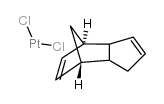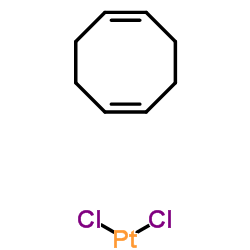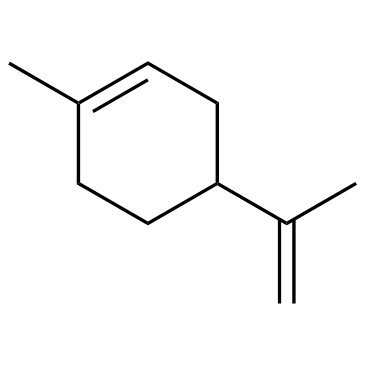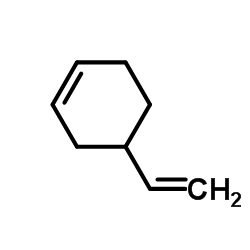Dichloro(dicyclopentadienyl)platinum(II)
Modify Date: 2025-08-24 17:01:19

Dichloro(dicyclopentadienyl)platinum(II) structure
|
Common Name | Dichloro(dicyclopentadienyl)platinum(II) | ||
|---|---|---|---|---|
| CAS Number | 12083-92-0 | Molecular Weight | 398.18600 | |
| Density | N/A | Boiling Point | 170ºC at 760mmHg | |
| Molecular Formula | C10H12Cl2Pt | Melting Point | 220-222°C (lit.) | |
| MSDS | N/A | Flash Point | 46.8ºC | |
| Name | dichloro(dicyclopentadienyl)platinum(ii) |
|---|---|
| Synonym | More Synonyms |
| Boiling Point | 170ºC at 760mmHg |
|---|---|
| Melting Point | 220-222°C (lit.) |
| Molecular Formula | C10H12Cl2Pt |
| Molecular Weight | 398.18600 |
| Flash Point | 46.8ºC |
| Exact Mass | 396.99600 |
| LogP | 3.76110 |
| Vapour Pressure | 1.99mmHg at 25°C |
|
Section 1: Product Identification Chemical Name:Dichloro(dicyclopentadienyl)platinum (II), 99% CAS Registry Number:12083-92-0 Formula:C10H12PtCl2 EINECS Number:None Chemical Family:metallocene Synonym:dicyclopentadienylplatinum dichloride
Section 2: Composition and Information on Ingredients IngredientCAS NumberPercentACGIH (TWA)OSHA (PEL) Title Compound12083-92-0100%1mg/m3(as-Pt)no data Section 3: Hazards Identification Emergency Overview:Irritating to the respiratory tract, skin and eyes. May be harmful if swallowed. Primary Routes of Exposure:Ingestion, inhalation, skin Eye Contact:Causes mild to moderate irritation of the eyes. Skin Contact:Causes slight to mild irritation of the skin. Inhalation:Irritating to skin, eyes and respiratory tract. Ingestion:Ingestion may lead to dizziness, abdominal cramps, and vomiting. Irritating to skin, eyes and respiratory tract. Exposure to platinum compounds may lead to wheezing, coughing, Acute Health Affects: and running of the nose. Skin exposure may lead to dermatitis. Chronic Health Affects:No information available on long-term chronic effects. NTP:No IARC:No OSHA:No SECTION 4: First Aid Measures Immediately flush the eyes with copious amounts of water for at least 10-15 minutes. A victim may need Eye Exposure: assistance in keeping their eye lids open. Get immediate medical attention. Wash the affected area with water. Remove contaminated clothes if necessary. Seek medical assistance if Skin Exposure: irritation persists. Remove the victim to fresh air. Closely monitor the victim for signs of respiratory problems, such as difficulty Inhalation: in breathing, coughing, wheezing, or pain. In such cases seek immediate medical assistance. Seek medical attention immediately. Keep the victim calm. Give the victim water (only if conscious). Induce Ingestion: vomiting only if directed by medical personnel. SECTION 5: Fire Fighting Measures Flash Point:not applicable Autoignition Temperature:none Explosion Limits:none Extinguishing Medium:carbon dioxide, foam or dry powder If this product is involved in a fire, fire fighters should be equipped with a NIOSH approved positive pressure Special Fire Fighting Procedures: self- contained breathing apparatus and full protective clothing. Hazardous Combustion andIf involved in a fire this material may emit toxic and corrosive fumes. Decomposion Products: Unusual Fire or Explosion Hazards: No unusual fire or explosion hazards. SECTION 6: Accidental Release Measures Small spills can be mixed with vermiculite, sodium carbonate or other suitable non combustible adsorbent and Spill and Leak Procedures: swept up. SECTION 7: Handling and Storage Handling and Storage:Store in a cool, dry place in a tightly sealed container. SECTION 8: Exposure Controls and Personal Protection Eye Protection:Always wear approved safety glasses when handling a chemical substance in the laboratory. Skin Protection:Wear protective clothing and gloves. Ventilation:To minimize exposure, handle the material in an efficient fume hood. If ventilation is not available a respirator should be worn. The use of respirators requires a Respirator Respirator: Protection Program to be in compliance with 29 CFR 1910.134. Ventilation:To minimize exposure, handle the material in an efficient fume hood. Additional Protection:No additional protection required. SECTION 9: Physical and Chemical Properties Color and Form:off-white pwdr. Molecular Weight:398.19 Melting Point:no data Boiling Point:no data Vapor Pressure:not applicable Specific Gravity:no data Odor:none Solubility in Water:insoluble SECTION 10: Stability and Reactivity Stability:air and moisture stable Hazardous Polymerization:no hazardous polymerization Conditions to Avoid:none Incompatibility:oxidizing agents, halogens, and active metals Decomposition Products:carbon dioxide, carbon monoxide, nitrogen oxides, hydrogen chloride, organic fumes, and platinum salts. SECTION 11: Toxicological Information RTECS Data:No information available in the RTECS files. Carcinogenic Effects:No data Mutagenic Effects:No data Tetratogenic Effects:No data SECTION 12: Ecological Information Ecological Information:No information available SECTION 13: Disposal Considerations Disposal:Dispose of according to local, state and federal regulations. SECTION 14: Transportation Shipping Name (CFR):Non-hazardous Hazard Class (CFR):NA Additional Hazard Class (CFR):NA Packaging Group (CFR):NA UN ID Number (CFR):NA Shipping Name (IATA):Non-hazardous Hazard Class (IATA):NA Additional Hazard Class (IATA):NA Packaging Group (IATA):NA UN ID Number (IATA):NA SECTION 15: Regulatory Information TSCA:Not listed in the TSCA inventory. SARA (Title 313):Not regulated by Title 313. Second Ingredient:None SECTION 16 - ADDITIONAL INFORMATION N/A |
| Hazard Codes | Xn |
|---|---|
| Risk Phrases | 36/37/38 |
| Safety Phrases | 26-36/37/39 |
| [Pt(dicyclopentadiene)Cl2] |
| Bis-(cyclopentadienyl)-platinum dichloride |
| Platinum,dichloro(3A,4,7,7A-tetrahydro-4,7-methanoindene) |
| (dicyclopentadiene)platinum(II) chloride |

![Tricyclo[5.2.1.02,6]deca-3,8-diene structure](https://image.chemsrc.com/caspic/118/77-73-6.png)
![[1E,5Z,pR]-1,5-Cyclooctadiene structure](https://image.chemsrc.com/caspic/193/5259-72-3.png)







